Cyclamen, SowbreadAlso called ArthanitaShajarah Maryam, Bukhur-I Maryam, Artanitha (Unani) |

|
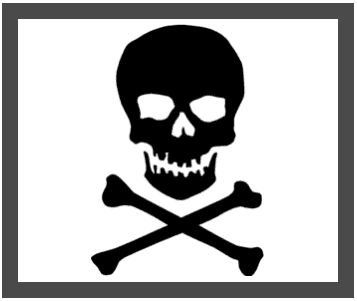
|
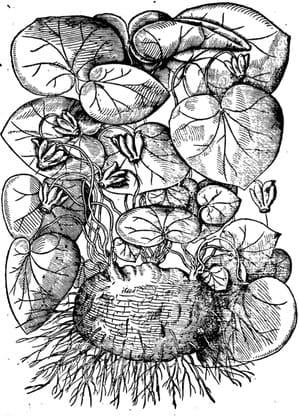 New Kreuterbuch,
New Kreuterbuch,Matthiolus, 1563 |
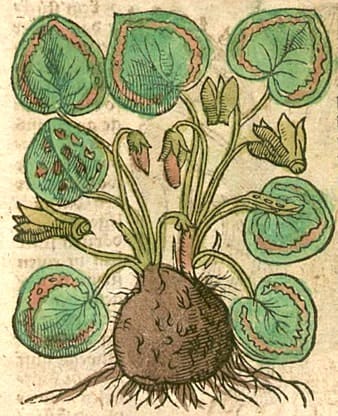 Kurtzes Handtbuchlein,
Kurtzes Handtbuchlein,Ryff, 1599 |
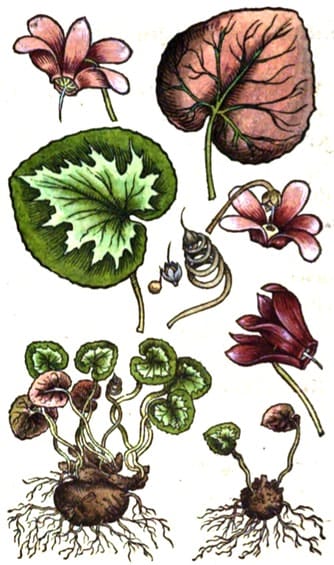 Kreutterbuch,
Kreutterbuch,Matthiolus, 1586 |
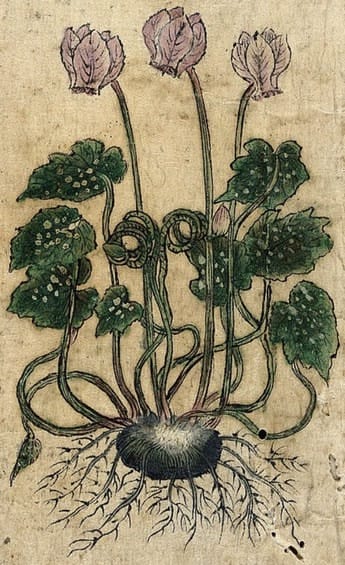 Japanese Herbal, 17th century
Japanese Herbal, 17th century(Welcome) |
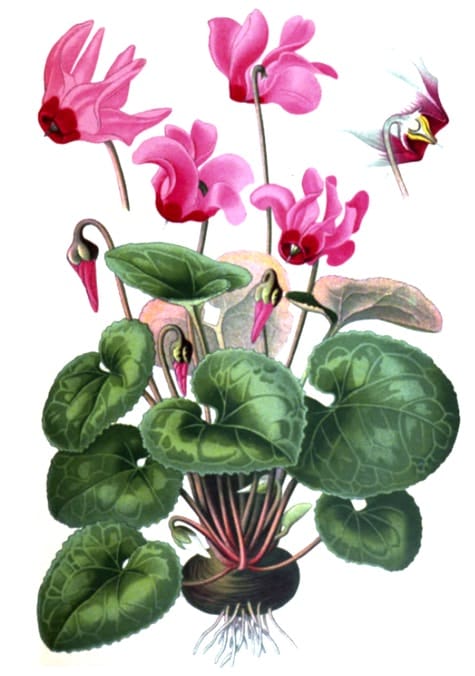 Cyclamen hederifolium
Cyclamen hederifoliumAtlas des plantes de jardins, Klincksieck, 1896
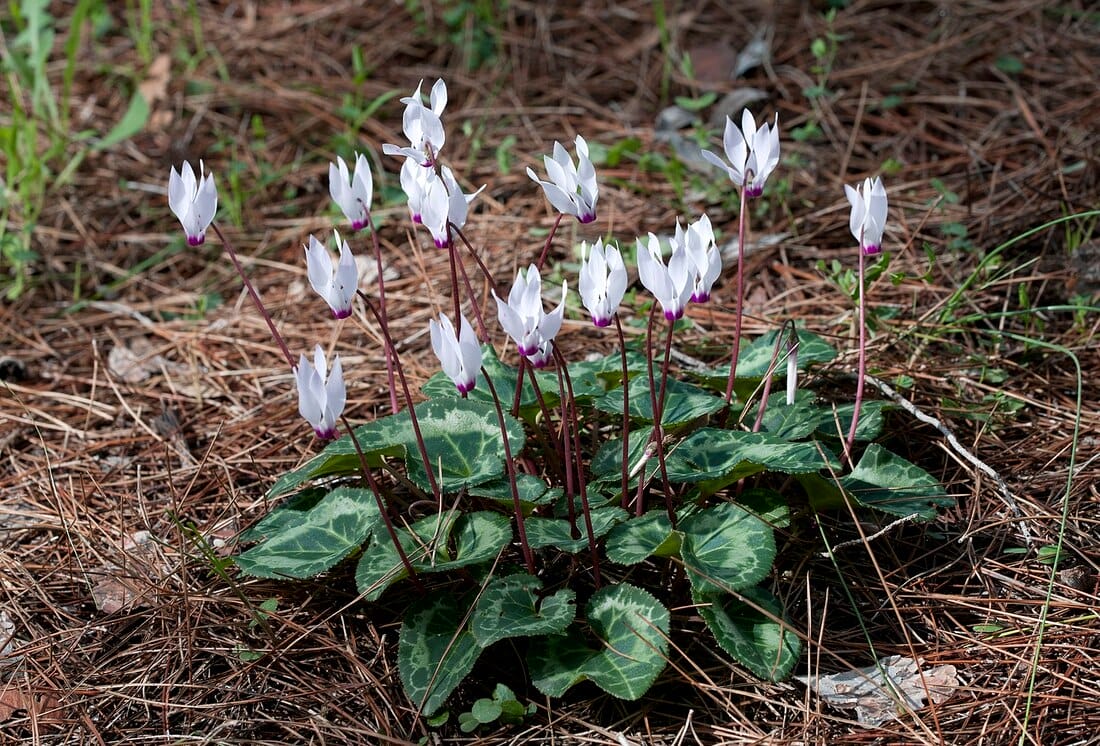 Cyclamen persicum
Cyclamen persicum(Photo by Zeynel Cebeci) (Wikimedia)
Botanical name:
Cyclamen spp.
Several species have been used:
- C. hederifolium
- C. europaeum
- C. graecum
- C. persicum and others
Parts used:
Root
Temperature & Taste:
Hot, dry. Pungent. Toxic
cuts powerfully, opens, cleanses
Classifications:
2C INCIDERS 2G. CLEANSING 2M. DRAWING
3K. EXPECTORANT
Uses:
1. Purges Cold Phlegm and Water:
-Cold Phlegm of the Lungs and cold Phlegm obstructions: Cough, Asthma, shortness of Breath
-severe Edema including Ascites (can be used as a wash over the lower abdomen)
-obstructed Urine; clears Stones
-Headache and cold diseases of the Head and Nerves
-“Some people recommend it for the patients of Asthma” (Avicenna)
2. Clears Cold Phlegm, Resolves Masses:
-Catarrh, Coryza
-Strumas, Scrofula,
-Arteriosclerosis (Atheromata)
-Hard Swellings of the Liver or Spleen
-Swellings, Tumors, Fibroids, Cancer (internally and externally)
-“extract dissolves Hard Swellings, Splenitis, Scrofula”. (Avicenna)
3. Clears Damp, Opens Obstructions of the Liver:
-opens the Liver
-damp-type Jaundice
4. Warms the Kidneys:
-Made into Troches as an Aphrodisiac. (Gerard)
5. Resists Poison:
-taken with wine to expel Poison and Venom
-decoction is used both topically and internally for Stings and Bites’. (Avicenna)
6. Strongly Promotes Menstruation
-previously used for obstructed Menstruation
-also to purge a Dead Child (not to be used like this today)
-leaf applied to the Navel helps women in labor (Pemell, 1652)
–Hippocrates used it for the Uterus
7. Externally:
-used topically wherever there is need to clear Water or Fluid.
-applied to all Cold Swellings, Scrofula
-applied over the lower abdomen, it purges Water in Edema and Ascites.
-applied topically to the bitings of Venomous Beasts
-hung around women in Labor to hasten
-applied topically to Hard Tumors including those of the Liver and Spleen.
-dropped into the Ears for Deafness or Tinnitus.
-applied as a lotion to help remove Cataracts (ancient Greeks)
-“The water of Greek Cyclamen with honey is suitable in cases of Cataract and weakness of Sight”. (Avicenna)
-It consumes Proud Flesh and is applied to chronic, stubborn and foul Ulcers and Fistulas.
-decoction applied heals Running (oozing) Sores
-topically for sores of the Mouth and Throat, Toothache
-applied to the lower abdomen promotes Menstruation.
-applied, the roots removes all Spots and Deformities of the Skin, such as the marks of Measles and Small Pox.
-“Its root cleanses the skin and removes Freckles”. (Avicenna)
-applied to Chilblains.
-decoction in vinegar is used as a wash for Alopecia.
-root bruised with Honey draws out Splinters, Thorns, Bone splinters etc.
-ashes mixed with vinegar is applied to the hip in Sciatica.
-topically for Nasal Polyps
-formerly used as a snuff to produce sneezing
-applied for Ptygerium (‘Pin and Web’)
-juice applied to the abdomen Kills Worms
Dose:
Use very cautiously internally, most commonly used externally.
Powder: 100–200mg, up to 300mg internally (begin with lower doses). Some older sources listed up to 1 dram (3 grams) of the root in powder, and 1–2 drams of the juice (which has been boiled).
ALCOHOLIC EXTRACT (1:5): 10–15 drops.
Comment:
1. According to Haehl (Advance of Med., 1936), primary indications for the use of Cyclamen are ‘a peculiar weakness, slackness, and sluggishness of the body and mind.’ This perfectly describes a Phlegm constitution from the Humoral viewpoint.
2. Pliny said if the root is put in a cup of wine, ‘makes as many drunk as drink it’.
3. “Some people have the opinion that the fresh Greek cyclamen is an ecbolic drug. When tied around the neck or forearm, it is said to prevent the pregnancy”. (Avicenna)
Correction:
1. It was not uncommon for such strong irritant medicines to be kept a year before use to lessen their virulence. This is a moderation of its strength, and is a type of correction.
2. Honey of Raisins; Manna; Mastic; Syrup of Quince; Oxymel; Hydromel; Sugar; Honey.
3. Chicken Broth.
4. Also corrected with Diarrhodon Abbatis.
Substitutes:
1. Turpeth
2. Prepared Arum (Tian Nan Xing)
Preparation:
1. Sometimes the juice was reduced down to the thickness of Honey.
2. It is probably in the category of medicines that can be prepared by steeping in Vinegar.
Main Combinations:
1. To Purge Pituitous (Damp) Humors, Cyclamen with Agaric, Chebulic Myrobalan and Turbith
2. Hard swellings and Tumors, Cyclamen with Polypody, Figwort and Betony (Wirtzung)
3. Topically for Deafness and Tinnitus:
i. Cyclamen boiled in Oil of Bitter Almond or Oil of Camomile and dropped into the Ears for Deafness or Tinnitus.
ii. Cyclamen bruised with Peach kernels, steeped in Brandy and dropped in the ears. (Pemell, 1652)
4. Pterygium (Corenal growths), Cyclamen jucie infused in honey in dropped into the eyes (Pemell, 1652)
5. Mouth and Throat Sores, mix Cyclamen juice with Honey or Plantain water and apply (Pemell, 1652)
6. Polyps, mix Cyclamen powder with Honey and apply
7. Sciatica and Arthritis of the Hip, Cyclamen ashes are mixed with vinegar and applied
8. Hemorrhoids, mix Agaric powder with a little Cyclamen juice and oil and apply (Pemell, 1652)
Major Formulas:
Confection for Hard Swellings
Cautions:
It is toxic in overdose.
1. Not used during Pregnancy. ‘It causes abortion’. (Avicenna)
2. Not used in the very young, old, or weak
3. Not used in Yin deficiency
4. “Oral intake of its root causes giddiness … Its use along with wine proves to be highly toxic“. (Avicenna)
Toxicity:
Toxic symptoms include gastroenteritis, sweating, dizziness, convulsions to fatal central paralysis.
Toxicity is due to saponins which cause hemoglobinuria and greatly increase coagulation of the blood.
Antidote:
1. Laurel berries (2 drams) in wine.
2. Powdered White Pepper (2 drams) (De venenis, Petrus, 1487)
Main Preparations used:
Ointment of Cyclamen was most used
